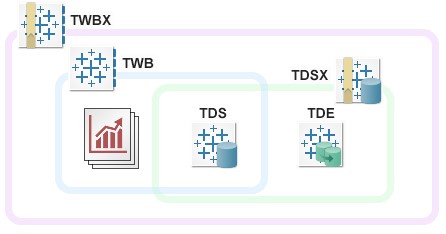This article is updated with the new icons from Tableau 10 and expanded for additional file types. Previous article for Tableau 9 here.
Acronyms, acronyms, acronyms – They dominate the internet, social media, everything. IMHO, probably too much. And, yes, Tableau is no different. It’s all just TMI. To help get you out of WTF and back to LMFAO, I’ve compiled all of the different Tableau file extensions, what they mean, and which are the most commonly used.
YW.
The Bread & Butter
These are the most common file extensions that a Tableau Desktop user will encounter.
 TWB
TWB
Tableau Workbook
The Tableau Workbook is the basic file type created by Tableau Desktop. This includes all of the worksheets, dashboards, story points, etc. Everything that you’ve done to the tabs within the workbook, such as mark colors, chart types, labels, border styles, etc. are recorded here. If you have a live connection to your data source, this is the type of file that you’ll create.
Automatically included within a TWB file is the TDS file, detailed below. Remember, your data does not reside inside of a TWB (or therefore a TDS either). Instead, the Tableau Workbook is XML code that Tableau Desktop generates to translate what you’ve done on your worksheets and dashboards.
Inside of the My Tableau Repository in your documents folder, new TWB files will be placed in the Workbooks folder.
 TDS
TDS
Tableau Data Source
The Tableau Data Source file includes all of the connection information and metadata about your data source. For instance, if you’ve changed aliases for your dimensions, revised number formatting, changed default aggregations, etc., then it will all be saved here. It also includes calculated fields, parameters, bins, hierarchies, groups and sets.
A TDS file is automatically included as a part of a TWB file, but it can also be saved as a separate file if you wanted to share the connection information as well as the metadata for that particular data source. To do this, right-click on the data source at the top of the Data pane and select Add to Saved Data Sources.
Inside of the My Tableau Repository in your documents folder, new TDS files will be placed in the Datasources folder.
 TDE
TDE
Tableau Data Extract
A Tableau Data Extract is a local copy of either the entire data source or a subset of that data. There are several reasons to create an extract, such as portability, performance and data control. Extracts that are created by Tableau are highly optimized for use in your visualizations. You have a great of control of how Tableau builds your data extract by using the Extract Data window from the Data Connection page.
A Tableau data extract is a columnar store. Any new columns that appear in your data source as a result of Tableau Desktop will also be included in your extract. This includes calculated fields, groups, hierarchies, sets, bins and even some default formatting (such as number formatting).
Inside of the My Tableau Repository in your documents folder, new TDE files will be placed in the Datasources folder.
 TWBX
TWBX
Tableau Packaged Workbook
The Tableau Packaged Workbook combines the workbook, the connection data and metadata and the data itself in the form on a TDE. If there are any images, such as background images, the packaged workbook will include those, as well. It is a completely portable workbook that can be shared or used offline. A TWBX file is required for another use to open the workbook using Tableau Reader. Think of a Tableau packaged workbook as a special set of zip files that are compressed together.
To save your workbook as a Packaged Tableau Workbook, when you save your workbook change the drop-down menu Save As Type to Tableau Packaged Workbook (*.twbx). Inside of the My Tableau Repository in your documents folder, new TWBX files will be placed in the Workbooks folder.
 TDSX
TDSX
Tableau Packaged Data Source
Similar to a TWBX, the Tableau Packaged Data Source is a combination of a couple of different files. The TDSX combines the data source metadata, connection info and the data extract. This is the most complete way to share your data because it also includes all the modifications and preparation you’ve done. Remember, this includes parameters, sets, hierarchies, groups, calculated fields, bins and all of the default formatting of your fields.
To create a TDSX file, right-click on the data source and select Add to Saved Data Sources. In the dialogue box that appears, change the Save As Type drop-down menu to Tableau Packaged Data Source (*.tdsx). Inside of the My Tableau Repository in your documents folder, new TDE files will be placed in the Datasources folder.
Now let’s figure out how all of these different file types interact together:

Remember, Tableau data source files and Tableau data extracts can exist within other files or can be saved alone. For instance, a TDS file will exist inside of a TWB, TWBX and a TDSX. For more detail on the specific differences between a TWB and TWBX, check this article out.
The Rest
The remaining file types are less commonly used by most Tableau users.
 TBM
TBM
Tableau Bookmark
A bookmark is used to earmark a specific worksheet. If you want to share just a worksheet and not the entire workbook or if you frequently access this worksheet, then use a Tableau bookmark. To create a bookmark, while on the worksheet you want to bookmark, go to the Window menu and select Bookmark > Create Bookmark. You can open the bookmark by clicking on the file icon or by selecting it under the Window menu.
Inside of the My Tableau Repository in your documents folder, new TBM files will be placed in the Bookmarks folder. If you choose to save the TBM file in a different place than the My Tableau Repository folder, then it will not appear in your Bookmarks menu inside of Tableau Desktop.
TDC
Tableau Datasource Connection
Tableau Datasource Connection files (TDC) are used to store settings and preferences for data connections. These types of files can be created with any text editor. They are typically saved in the Datasources folder in My Tableau Repository or within the Tableau Server program files.
Here’s an example of configuring a TDC file on an ODBC connection. The TDC file is referenced under the heading “Making customizations global.”
NOTE: Finding a file image for TDC has proven very difficult, and I’ve yet to find one. As such, I left it blank for now.
 TMS
TMS
Tableau Map Source
Tableau comes native with a connection to Tableau’s map server. If you connect to a map server that does not support the WMS standard, you’ll need to create a TMS file. Check out this article for more information on TMS files.
 TPS
TPS
Tableau Preferences
If you want to create a custom color palette, you can create them inside of your Tableau Preferences file. It is located in the top level folder of the My Tableau Repository folder. Remember, Power Tools for Tableau has the free Color Tool to easily create your own palette.
ICYMI …
We have a comments section just below this article. We’d love to hear your thoughts, questions or suggestions. Sorry, if this article was TL/DR, you can always bookmark us and reference this article when these file extensions pop up.
BFN and as always … THX for reading!


